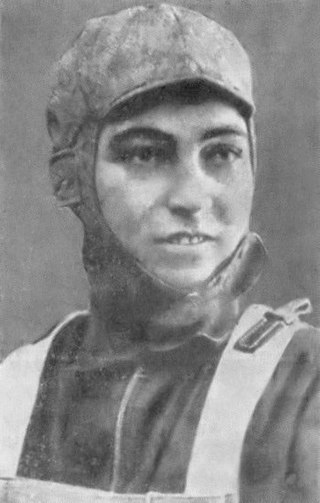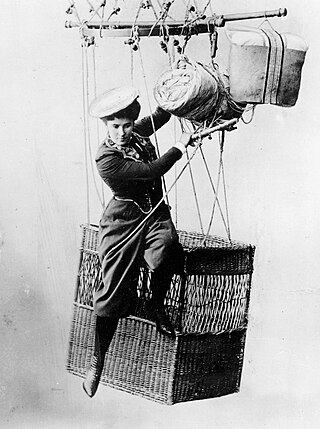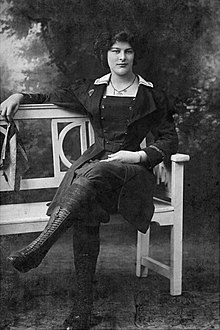
Joseph William Kittinger II served as a United States Air Force (USAF) officer from 1950 to 1978. He was a fighter pilot who earned Command Pilot status and retired as a colonel. He held the world record for the highest skydive—102,800 feet (31.3 km)—from 1960 until 2012.

Ashby-de-la-Zouch, sometimes spelt Ashby de la Zouch and shortened locally to Ashby, is a market town and civil parish in the North West Leicestershire district of Leicestershire, England. The town is near to the Derbyshire and Staffordshire borders. Its 2001 census population of 11,410 rose to 12,370 in 2011. The castle in the town was an important fort in the 15th–17th centuries. In the 19th century the town's main industries were ribbon manufacture, coal mining, and brickmaking.

High-altitude military parachuting, or military free fall (MFF), is a method of delivering military personnel, military equipment, and other military supplies from a transport aircraft at a high altitude via free-fall parachute insertion. Two techniques are used: HALO and HAHO.

Project Excelsior was a series of parachute jumps made by Joseph Kittinger of the United States Air Force in 1959 and 1960 from helium balloons in the stratosphere. The purpose was to test the Beaupre multi-stage parachute system intended to be used by pilots ejecting from high altitude. In one of these jumps Kittinger set world records for the longest parachute drogue fall, the highest parachute jump, and the fastest speed by a human through the atmosphere. He held the latter two of these records for 52 years, until they were broken by Felix Baumgartner of the Red Bull Stratos project in 2012, though he still holds the world record for longest time in free fall.

The Parachutist Badge, also commonly referred to as "Jump Wings" is a military badge of the United States Armed Forces. The United States Space Force and United States Coast Guard are the only branches that do not award the Parachutist Badge, but their members are authorized to receive the Parachutist Badges of other services in accordance with their prescribed requirements. The DoD military services are all awarded the same Basic Parachutist Badge. The U.S. Army and U.S. Air Force issue the same Senior and Master Parachutist Badges while the U.S. Navy and U.S. Marine Corps issue the Navy and Marine Corps Parachutist Badge to advanced parachutists. The majority of the services earn their Basic Parachutist Badge through the U.S. Army Airborne School.

André-Jacques Garnerin was a French balloonist and the inventor of the frameless parachute. He was appointed Official Aeronaut of France.

Leslie Leroy Irvin was a stunt-man for the fledgling Californian film industry. Flying in balloons, he performed using trapeze acrobatics and parachute descents. For the 1914 film Sky High, Irvin made his first jump out of an airplane while flying at 1,000 feet above the ground. In 1918, he developed his own life-saving static line parachute, jumping with it several times and promoting it to the US Army. Irvin joined the Army Air Service's parachute research team at McCook Field near Dayton, Ohio where he made the first premeditated free-fall jump with the modern parachute on April 28, 1919.

Georgia Ann "Tiny" Thompson Broadwick, or Georgia Broadwick, previously known as Georgia Jacobs, and later known as Georgia Brown, was an American pioneering parachutist and the inventor of the ripcord. She was the first woman to jump from an airplane, and the first person to jump from a seaplane.

Similar to skydiving, space diving is the act of jumping from an aircraft or spacecraft in near space and falling towards Earth. The Kármán line is a common definition as to where space begins, 100 km (62 mi) above sea level. This definition is accepted by the Fédération Aéronautique Internationale (FAI), which is an international standard setting and record-keeping body for aeronautics and astronautics. The United States Air Force uses 50 mi (80 km) to award astronaut wings.

Smaranda Brăescu was a Romanian parachuting and aviation pioneer, former multiple world record holder. Her achievements earned her the nickname "Queen of the Heights".
Edith Maud Cook, was an early British parachutist, balloonist, and aviator, recognized as Britain's first female pilot. She was also known as Viola Spencer-Kavanagh, Viola Spencer, Viola Kavanagh, and perhaps as Viola Fleet and Elsa Spencer.

Jeanne Geneviève Garnerin was a French balloonist and parachutist. She was the first to ascend solo and the first woman to make a parachute descent, from an altitude of 900 metres (3,000 ft) on 12 October 1799.
CharlesBroadwick was an American pioneering parachutist and inventor. Speaking about Broadwick, an executive director of the U.S. Parachute Association, Ed Scott, said "just about all modern parachute systems" use ideas Broadwick developed: "an integrated, form-fitting harness and container system nestled on the back." Broadwick also developed the static line, a line from a parachute to an aircraft that pulls the parachute from its pouch. Static lines are still used today, for instance by paratroopers and novice skydivers. U.S. Army Warrant Officer Jeremiah Jones commented, "[Broadwick] is like the grandfather of paratroopers." In addition, Broadwick demonstrated parachute jumps at fairs and taught and equipped famous female parachutist Tiny Broadwick.
Dilys Price was a Welsh educator, parachutist, and model who held the record for the oldest female solo parachute jump at the age of 80. She founded the charity Touch Trust to provide art and creative movement activities.

Robert Alan Eustace is an American computer scientist who served as Senior Vice President of Engineering at Google until retiring in 2015. On October 24, 2014, he made a free-fall jump from the stratosphere, breaking Felix Baumgartner's world record. The jump was from 135,890 feet (41.42 km) and lasted 15 minutes, an altitude record that stands as of 2022.
Elizabeth Ridgeway was an English woman convicted of poisoning her husband. While awaiting execution by burning at the stake, she confessed to previously poisoning her mother, a fellow servant, and a lover.

Élisa Garnerin was a French balloonist and parachutist. She was the niece of the pioneer parachutist André-Jacques Garnerin, and took advantage of his name and of the novelty of a woman performing what were at the time extremely daring feats. She was a determined businesswoman, and at times got into trouble with the police for the disturbance her performances caused, failure to pay all taxes due and failure to deliver all that her advertising had promised. She toured the provinces of France, Spain, Italy, and other parts of Europe, making 39 descents in all between 1815 and 1835.

Katharina "Käthe" Paulus was a German exhibition parachute jumper and the inventor of the first collapsible parachute. At the time, 1910, the parachute was named "rescue apparatus for aeronauts". The previous parachutes were not able to fit in a case like apparatus worn on the back, thus Paulus' invention became of paramount importance for the Germans in the First World War and she produced about 7,000 parachutes for the German forces. During the First World War, Paulus created approximately 125 parachutes a week. She was also credited with inventing the "drag 'chute", an intentional breakaway system where one small parachute opens to pull out the main parachute.
Odette Rousseau was a French parachutist. She qualified at the age of 23 and became French national champion in 1953 and a world champion in 1954. Rousseau made a world record jump on 25 August 1955 from a height of 8,721 metres. She later attended many Fédération Aéronautique Internationale committees and was appointed an officer of the Legion of Honour.

Charles Green Spencer (1837–1890) was a pioneer aviator who founded the balloon manufacturing company C. G. Spencer & Sons.














